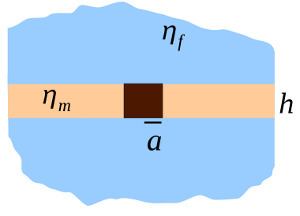 | ||
The Saffman–Delbrück model describes a lipid membrane as a thin layer of viscous fluid, surrounded by a less viscous bulk liquid. This picture was originally proposed to determine the diffusion coefficient of membrane proteins, but has also been used to describe the dynamics of fluid domains within lipid membranes. The Saffman–Delbrück formula is often applied to determine the size of an object embedded in a membrane from its observed diffusion coefficient, and is characterized by the weak logarithmic dependence of diffusion constant on object radius.
Contents
Origin
In a three-dimensional highly viscous liquid, a spherical object of radius a has diffusion coefficient
by the well-known Stokes–Einstein relation. By contrast, the diffusion coefficient of a circular object embedded in a two-dimensional fluid diverges; this is Stokes' paradox. In a real lipid membrane, the diffusion coefficient may be limited by:
- the size of the membrane
- the inertia of the membrane (finite Reynolds number)
- the effect of the liquid surrounding the membrane
Philip Saffman and Max Delbrück calculated the diffusion coefficient for these three cases, and showed that Case 3 was the relevant effect.
Saffman–Delbrück formula
The diffusion coefficient of a cylindrical inclusion of radius
where the Saffman–Delbrück length
The Saffman–Delbrück formula predicts that diffusion coefficients
Beyond the Saffman–Delbrück length
Hughes, Pailthorpe, and White extended the theory of Saffman and Delbrück to inclusions with any radii
A useful formula that produces the correct diffusion coefficients between these two limits is
where
Experimental studies
Though the Saffman–Delbruck formula is commonly used to infer the sizes of nanometer-scale objects, recent controversial experiments on proteins have suggested that the diffusion coefficient's dependence on radius
